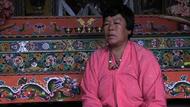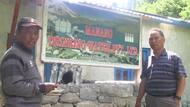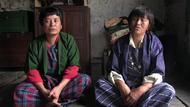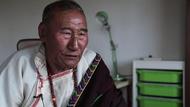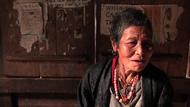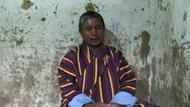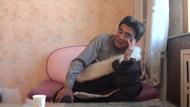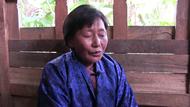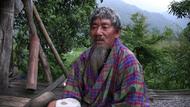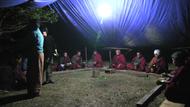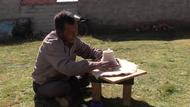Video Overview
Kelzang Döndrup explains various nomad handicrafts from the É district.
- Lhokha
- འབྲོག་པ་ Nomadལྟ་ཕྱིང་ཁུག་ནི། འོ་འདི་ལ་ཕྱིང་ཁུག་བྱས་བྱས་དུས་ཚེས་གཉིས་ལ་བེད་སྤྱོད་གཏོང་གི་ཡག་ཡིན་པ་རེད།This one is called chingkhuk which we mainly use on two different occasions.
- དྲི་བ་ལེན་མཁན་ Questionerལགས་སོ།Okay.
- འབྲོག་པ་ Nomadདུས་ཚོད་གཉིས་ལ། ལྟ་ནི་ལྟ་གཙོ་བོ་ག་རེ། འབྲོག་པ་ལྟ་རྟེན་འབྲེལ་བྱེད་པའི་གོང་ལ་གཅིག་བྱས།One occasion is when we observe one of our nomadic ceremonies.
- རྟེན་འབྲེལ་བྱས་གོང་དུ་གང་འདྲས་སེ་བྱེད་ཀྱི་ཡོག་རེད་ཟེར་ན་ཁོ། ང་ཚོ་འོ་མ་བཞོ་ཡག་ཡོད་པཱ། འབྲི། འབྲི་དེ་ཚོ་ལ་རྟེན་འབྲེལ་བྱས་ནས།In which we bring the female yaks that we use for milking.
- འཁོར་རས་གཡོགས། འཁོར་རས་ཟེར་གྱི། སྐེ་སྒོར་ཟེར་གྱི་རེད། འཁོར་རས་ཟེར་གྱི་རེད། ང་ཚོས་ཟེར་ན་འཁོར་རས་ཟེར་གྱི་རེད།Then we put the round khoré on the neck of the animal. It is called khoré. It's also known as kegor.
- འོ་དེ་གཡོགས་བྱས་འདི་ནས་དེ་ལ་གཟེར་ཁ་བརྒྱབ། འབྲི་དེ་ལ་གཟེར་ཁ་བརྒྱབ། འདི་ཁོ་བསངས་བཏང་། འོ་འདུག་སེ་བྱས། འོ་འདུག་སེ་བྱས་འོ་འདི་ལ་གཅིག་བེད་སྤྱོད་གཏོང་གི་རེད།We put that (kegor) on the female yaks, put the nails, and hold a incense burning ceremony.
- ལྟ་གཉིས་པ་དེ་གང་འདྲ་སེ་རེད་ཟེར་ན་ལྟ། ཡང་ང་རང་ཚོ་འབྲོག་པའི་ཀ་ར་ཡོང་དུས་འོང་ཀ་ལ་ཟེར་ཡང་མར་བག་ཆུང་དང་སྐྱེ་འཕེལ་བྱང་ཆུབ་བྱས་བྱས་ཡང་ཁོ། ཇ་ཁ་དཀྲོལ་དགོས་ས་ཡང་གཡག་འཁྲིད་བྱས་ཇ་ཆང་ཟེར་གཅིག་བཏུང་གི་རེད། འོ་དེ་དུས་གཅིག་བེད་སྤྱོད་གཏོང་གི་རེད། དུབ་ལོག་(གོས་ལོག་)འོ་འདི་ཚོ་ཡོངས་བེད་སྤྱོད་གཏོང་གཙོ་བོ།The other occasion is when we gather together for a productive year. On that day, we also bring our yak, dress in a custom that I am wearing now, and feast with tea and chang (Tibetan barley beer).
- གཞན་ནམ་རྒྱུན་ལྟ་ཁོ་དགོས་ཡག་ཡོག་མ་རེད། འོ་འདུག་སེ་ཡིན།Usually we don't need it. That is all.
- ལྟ་ཁོ་རང་ཕྱིང་ཁུག་འདི་ལ་ཆ་བཞག་པ་ཡིན་ན་ཁོ་ར་ཕྱིང་ཁུག་སྐར་མ་སྨིན་དྲུག་བྱས།The name of this pouch is Chingkhuk Karma Mindruk.
- ཁོ་ག་རེ་ལ་དཔེ་བཞག་པ་རེད་ཟེར་ན། བུམ་པ་ལ་དཔེ་བཞག་པ་རེད་ལྟ་ཁོ། འདི་བུམ་པ་དེ་ཟེར།And it is compared to a vase.
- ལྟ་འདི་ཁོ་ར་བུམ་པའི་གཞོགས་བྱས། འདི་བུམ་པ་རང་དེ་བྱས། དེ་ཚོ་ལ་ནི་གཙའུ་གཙའ་ཤུབ། གཙའུ་གཙའ་ཤུབ་ཟེར་གྱིས། ལྟ་འདི་ཁོ་ར་རྒྱན་ཆ་བྱས།This is the face of the vase. These are called tsau tsashup. These are mainly decoratives.
- ལྟ་དེ་ལ་དཔུང་དཀྲིས་སེ་བྱས། ལྟ་གཙའུ་འདི་འཇུག་ལ་འདི་འོ་འདུག་སེ་བཏགས།This one is called pungtri. We keep the tsau here. Those are the names.
- དྲི་བ་ལེན་མཁན་ Questionerདུས་ཚོད་གཅིག་གསུང་གནང་དང་།Please tell us the date.
- འབྲོག་པ་ Nomadདུས་ཚོད་ནི་ཕྱི་ཟླ་༧ཚེས་པ་༡ལ་རེད། ཏག་ཏག་བྱེད་ཀྱི་རེད། རྟེན་འབྲེལ་བྱེད་ཡག་དེ།་Every time, the ceremony will be held on July 1st.
- ལྟ་འདིའི་འདི་བྱས་ནས་ལྟ་ཁོ་ར་ཡང་འདི་དང་པོ་འདི་ཇ་ཆང་འདྲེན་ནས་ལྟ། བོད་ཟླ་དང་པོའི་ཡང་ཚེས་པ་བརྒྱད་དགུ་ལ་རྟེན་འབྲེལ་དང་མ་སོང་ནའི་འོ་འདུག་སེ་བྱེད་ཀྱི་རེད།Also around the eighth day of first Tibetan lunar month, we observe the ceremony by offering tea and chang.
- འོ་འདུག་སེ།Like that.
- དྲི་བ་ལེན་མཁན་ Questionerཨཱ་ནི་དཔུང་དཀྲིས་ཟེར་ཡག་དེ་འགྲེལ་བཤད་ཤིག་བསྐྱོན་གནང་དང་།Please tell us little about the pungtri.
- འབྲོག་པ་ Nomadའདི་ལ་དཔུང་དཀྲིས་ཟེར་བྱས་ལྟ་འདི་འབྲིའི། ལྟ་སེམས་ཅན་འདིའི་ལག་པ་བསྡམས་ཡག་ཡིན་ལྟ་ཁོ། ལག་པ་བསྡམས་ཡག་བྱས་ འདི་འདྲས་སེ་བྱས་འོ་འདུག་སེ།This one is called pungtri. We use it to tie the female yak's feet.
- དྲི་བ་ལེན་མཁན་ Questionerའོ་མ་བཞོ་དུས་རེད་པས།Is it when you milk the animal?
- འབྲོག་པ་ Nomadའོ། འོ་མ་བཞོ་དུས་ཡིན་ནའི་འདྲ་འདུག ལྟ་གཞན་དག་ཕར་ཡིན་ནའི་འདྲ་ཁོ་བེད་སྤྱོད་འོ་འདུག་སེ་གཏོང་གི་རེད།Yes. We use it when we milk the animal as well as for other purposes.
- ཐག་པ་འདི་ལྟ་ཁོ་ར་ཤ་ཐག་བྱས་བྱས་ད་ག་དོ་རུབ་བྱས་བྱས་ཁོ་ཨཱ་ནི་སེམས་ཅན་ཟིན་ནས་གཡོགས་བྱས་འོ་འདུག་སེ་ཡིན།This robe is called shatak which we use for catching the animal like a lasso.
- དྲི་བ་ལེན་མཁན་ Questionerཨཱ་ནི་རིང་ཚད་ལ་འདོམ་པ་དྲུགIs it six dompas [arm spans] long?
- འབྲོག་པ་ Nomadའོ་རིང་ཚད་ལ་འདོམ་པ་དྲུག་དང་ཕྱེད་ཀ་ཡོག་རེད།Yes. It is six and a half dompas long.
- འོ་འདུག་སེ། འོ་འདུག་སེ།So it is like that.
- དྲི་བ་ལེན་མཁན་ Questionerགཉིས་པ་དེ་ག་དུས་རེད།When is the second event?
- འབྲོག་པ་ Nomadལགས་འོང་།What?
- དྲི་བ་ལེན་མཁན་ Questionerགཉིས་པ་དེ་ག་དུས་རེད།When is the second event?
- འབྲོག་པ་ Nomadགཉིས་པ་དེ་བོད་ཟླ་དང་པོའི།The second one is held in the first Tibetan month.
- དྲི་བ་ལེན་མཁན་ Questionerལོ་གསར་ལ།Is it during the Tibetan New Year?
- འབྲོག་པ་ Nomadའོ་འོ། ལོ་གསར་ཚེས་པ་བརྒྱད་ནས་འགོ་ཚུགས་བྱས་དེ་ནས་འདུག་སེ་བྱེད་ཀྱི་རེད།Yes, starting from the eighth day of Tibetan New Year.
- དྲི་བ་ལེན་མཁན་ Questionerདེ་དུས་འབྲོག་པ་མཉམ་འཛོམས།So all the nomads will get together. Right?
- འབྲོག་པ་ Nomadའོ་འོ། མཉམ་འཛོམས་རེད། གང་ག་མཉམ་འཛོམས་བྱས་བྱས་དེ་ཁོ་འོ་དེ་དུས་གཡག་འཁྲིད་བྱས་ཁོ། ལྟ་དབྱར་ཕྱུགས་བཏང་། ཁོ་ཁོ་ར།Yes. We all get together. Each one of us will bring our animals and graze them.
- ཨཱ་ནི་གཡག་དང་མ་སོང་ནའི་འ་དེ་ཚོ་གཡག་ཇ་གདོང་བརྒྱབ་རླན་པོ་དཀར་པོ་དེ་ཚོ་བརྒྱབ་བྱས་འོ་འདུག་སེ་བྱེད་ཀྱི་རེད།We decorate the yaks and mark them with white color.
- དཀར་པོ་དེ་བརྒྱབ་བྱས་རྟེན་འབྲེལ་འོ་འདུག་སེ་བྱེད།With white marking, that is how we observe the ceremony.
- འོ་དེ་དུས་ཚོད་གཉིས་ལས་ཁོ་བེད་སྤྱོད་གཏོང་ཡག་ཡོག་རེད་ལྟ།So those are the only two occasions during which we use it.
- དྲི་བ་ལེན་མཁན་ Questionerལྟ་དེའི་ནང་ལ་ག་རེ་བླུགས་ཡོག་རེད།What do you put inside that pouch?
- འབྲོག་པ་ Nomadལྟ་འདིའི་ནང་ལ་ལྟ་རྩམ་པ་བླུགས་ཀོ། རྩམ་པ་བླུགས་བཞག་ཡོག་རེད། ལྟ་འདིའི་ནང་ལ།We put tsampa (roasted barley flour) inside that.
- འང་སེམས་ཅན་ལ་སྟེར་ཡགTo feed the animals.
- འོ་འདུག་སེ་ཡིན།That is all.
- དྲི་བ་ལེན་མཁན་ Questionerའདི་སྟེར་ན་ག་རེ་ཡོག་རེད།Why do you feed it?
- འབྲོག་པ་ Nomadལགས་འོང་།What?
- དྲི་བ་ལེན་མཁན་ Questionerརྩམ་པ་དེ་དམིགས་བསལ་སྟེར་གྱི་རེད་པས།Is this tsampa a special kind of treat?
- འབྲོག་པ་ Nomadདམིགས་བསལ་ཁོ་ར་འདི་རྩམ་པ་དེ་ཚོ་ཚྭ་བསྲེས་བྱས་ཁོ་སྟེར་ཀ་ཕྱིན།The tsampa is mixed with some salt and give it to the animal.
- ལྟ་འདི་ཚོ་མགྲོན་བུ་དེ་ཚོ་ལྷ་ས་ནས་ཉོས། ཀོ་བ་ཡོག་རེད། མིག་དེ་བཟོས།We buy those shells on the cover from Lhasa and create eyes with leather.
- ལྟ་འདི་ནི་བཟོ་པའི་རྩ་ན་ཉོ་ཡག་ཡོག་རེད། ཉོས་འདི་བཟོ་བྱས་འོ་འདུག་སེ། འོ་ལྟ་ཡུག་ཁོ་ར་རྟེན་འབྲེལ་དང་མ་སོང་ནའི་འོ་འདུག་སེ་བྱེད་ཀྱི་རེད།This one we can buy from artisans. We buy it and attach it here. That is the one we use during the ceremony.
- དྲི་བ་ལེན་མཁན་ Questionerལྟ་གཙོ་བོ་རྟེན་འབྲེལ་རེད། རེད་པཱ།It's mainly a ceremonial good. Is that correct?
- འབྲོག་པ་ Nomadརེད་ལགས།Yes.
- ཁོ་རྟེན་འབྲེལ་ཆེད་དུ་ཡིན་ཕྱིང་ཁུག ཡོད་ཡག་བྱས་ན་འདི་འདྲས་མེད་རྒྱོག་དེ་བཟོས་བྱས་འདི་པ་སེམས་ཅན་ལ་རྟག་ཏུ་དགོས་རེད།This chingkhuk is for the ceremony. However, we have ordinary one that we use daily.
- དྲི་བ་ལེན་མཁན་ Questionerཨཱ་ནི་ཕྱུ་པ་འདི་འབྲེལ་བཤད་ཅིག་འབྲེལ་བཤད་དང་།Please explain the chupa dress you are wearing.
- འབྲོག་པ་ Nomadཕྱུ་པ་དེ་ལྟ་མགོ་ཤུབས་ཟེར། མགོ་ཤུབས། ནམ་རྒྱུན་ནས་རྟག་ཏུ་གྱོན་ལྟ་ང་ཚོ་འབྲོག་པས་འོ་མ་བཞོ་སར་གྱོན་ནས། ནི་གང་བྱས་ལྟ་ཆུ་མ་སླེབས་ཡག་ཆེད་དུ།This chupa dress is called goshup. We, the nomads, wear it in our daily life when we milk the animal or do other works. It keeps us dry.
- འདི་ལྟ་འདུག་སེ་བྱས།Like this.
- ཁོ་སྟབས་བདེ་པོ་བྱས།It is very convenient.
- དྲི་བ་ལེན་མཁན་ Questionerའོ་འོ།I see.
- འབྲོག་པ་ Nomadའདིར་ལག་པ་འདུག་སེ་བཅུག འདི་ནང་བཅུག་ས་བྱས་དྲོ་པོ་བྱས།We can put our hand here to keep them warm.
- ཡང་འདོན་ནས་འཚིག་དུས་མཚམས་རེ་ཕར་གཡུགས། འདུག་སེ་བྱས་ཡང་བུ་སུག་དོག་ནས་འདུག་སེ་བྱས་ཡང་ཁོ་འདོགས་ས་བྱས།If you feel hot or uncomfortable, then you can turn them up. Like this.
- འོ་འདུག་སོ་ཁོ་སྟབས་བདེ་པོ་དང་མ་སོང་ནའི།It is very convenient to use.
- དྲི་བ་ལེན་མཁན་ Questionerདེ་ལ་ག་རེ་ཟེར་གྱི་རེད།Do you have a name for it?
- འབྲོག་པ་ Nomadའདི་ལ་དཔུང་ཤོག་ཟེར་འདི།It is called pungshok.
- འོ་མ་བཞོ་དུ་ཞོགས་ཀས་འདུག་སེ་བྱས།ཾWhen milking the animal, we do like this.
- ཡང་ཆར་པ་བཏང་ན་འདུག་སེ་བྱས་མ་སྦང་བ་བྱས།If it rains, it keeps us dry.
- ལྟ་ཆུ་འོག་མ་ཕྱིན།Water drops will fall off.
- དྲི་བ་ལེན་མཁན་ Questionerཨཱ་ནི་ཀོང་པོའི་ཕྱུ་པ་དང་ཁྱད་པར་ག་རེད་ཡོག་རེད།What is the difference between this chupa dress and that of Kongpo dress?
- འབྲོག་པ་ Nomadལགས་འོང་།What?
- དྲི་བ་ལེན་མཁན་ Questionerམ་འདྲ་བ་ར་ཅིགAny differences?
- འབྲོག་པ་ Nomadམ་འདྲ་ར་འདི་གཙོ་བོ་འདི་རེད། ཕྱུ་པ་གཞན་དང་མ་འདྲ་དེ། ཁོ་གང་བྱས་ཆུ་མ་སླེབས་ཡག་ཆེད་དུ། ལྟ་ཁོ་འདུག་སེ་བཟོས་བཞག་འདུགThis part is the main difference, it is designed like this to prevent water
- དྲི་བ་ལེན་མཁན་ Questionerརྒྱུ་འདི་སྣམ་བུ་མ་གཏོགས་ཀྭོ་བ་གིས་བཟོ་གི་མ་རེད་པས།Do you use an animal skin other than nambu (woolen cloth) as a material for making this dress?
- འབྲོག་པ་ Nomadབཟོ་གི་མ་རེད། འདི་ཡང་བལ་འདུག་སེ་བྱས། ཡང་ཁོ་ར་སྤུ་སྤུ་རྐྱང་ཁོ་ར། སེམས་ཅན་སྤུ་ན་བཟོ་གི་ཡོག་རེད་འདི། བལ་ཟེར་ཡག་དེ།No, we don't use animal skin. It is made from animal hairs.
- དྲི་བ་ལེན་མཁན་ Questionerལུག་རེད་པས་གཡགIs it sheep's wool or yak's hairs?
- འབྲོག་པ་ Nomadགཡག་གི་སྤུ་ནས་མ་གཏོགས་ལུག་གི་བལ་དེ་ཚོ་འགྲོ་ཐུབ་ཀྱི་མ་རེད།We use yak's hairs, not sheep's wool.
- འདི་ཁོ་ར་ཆུ་འདྲེད་བརྡར་རྒྱག་བྱས་འགྲོ་གིས་འདུག་སེ། ཆར་པ་བཏང་དུས། གཅིག་ཁོ་གཅས་ཁོ་ར་ཕར་ཟུག་སླེབས་ཀྱི་མ་རེད་ཁོ།The rainwater will fall off the dress like this. You won't get wet.
- འོ་འདུག་སེ་ཡིན།That is.
- དྲི་བ་ལེན་མཁན་ Questionerགཙའུ་གཙའ་ཤུབ་གང་རེད། བེདསྤྱོང་གང་དུ་གཏོང་གནང་གི་ཡོག་རེད།What is tsau tsashup? Where do you use it?
- འབྲོག་པ་ Nomadའདི་ལྟ་གང་བྱས་འདི་ད་ཚོད་གང་བྱས་ལྟ་ཟླ་བ་བཞི་པའི་ཚེས་པ་བཅོ་ལྔ་འགྲོལ་ནས་ཁོ་ཁྲག་རྒྱག་ཡག་རེད།We use it during the fourth month for drawing blood.
- དྲི་བ་ལེན་མཁན་ Questionerབོད་ཟླ་རེད་པས།Is it Tibetan month?
- འབྲོག་པ་ Nomadའོ། བོད་ཟླ།Yes, it's Tibetan month.
- ལྟ་འདི་འདི་ནས་གང་བྱས་བོད་ཟླ་དྲུག་པའི་རིང་བདུན་པ་ནས་ལྟ་ཁོ་མཚམས་འཇོག་བྱས་ནས་ཤ་ཤེད་སླེབས་འགྲོ་དུས་ཁོ་མཚམས་འཇོག་དང་མ་སོང་ནའི་བྱས།The practice will continue till the end of the sixth Tibetan lunar month when the animals gain strength and health. And then we stop using it.
- དྲི་བ་ལེན་མཁན་ Questionerཁྲག་རྒྱག་ཡག་དེ་གཙོ་བོ་ག་རེ་རེད་པས།What is the main reason?
- དྲི་བ་ལེན་མཁན་ Questionerགང་རེ་བྱས།Why do you do that?
- འབྲོག་པ་ Nomadབོད་ཟླ་བཞི་པའི་ཚེས་པ་བཅོ་ལྔ་འགྲོལ་ནས་ལྟ་ཁོ་བེད་སྤྱོད་གཏོང་དགོས། ཁོ་ཁྲག་བརྒྱབ་ནས་སེམས་ཅན།We start using it after the fifteenth day of the fourth lunar month. To draw blood from the animals.
- ཨཱ་ནི་དྲུག ཟླ་བ་དྲུག་པ་རྫོགས། དེ་བདུན་པ་ནས་བེད་སྤྱོད་གཏོང་ཡག་མ་རེད། ཤ་ཤེད་སླེབས་དུས་ཁྲག་དེ་རྒྱག་ཆོག་གི་མ་རེད་ལབ་ཀོFrom the seventh lunar month onward, we don't use it. As a general practice, we don't use it after animals improved their health and strength.
- ཡང་སེམས་ཅན་དེ་སྐྱོ་པོ་ཆགས་འགྲོ་གི་རེད།Otherwise, they will become weak.
- དྲི་བ་ལེན་མཁན་ Questionerགཙོ་བོ་ཤ་ཤེད་རྒྱས་ཡག་ཆེད་དུ་རྒྱག་གི་ཡོག་རེད་པས།It is mainly used to make the animal healthy and strong. Is that right?
- འབྲོག་པ་ Nomadའོ། གཙོ་བོ་ཤ་ཤེད་རྒྱས་ཡག་ཆེད་དུ་རྒྱག་གི་ཆེད་དུ་ལྟ་ང་ཚོ་ཁྲག་དང་མ་སོང་ནའི་ནང་ཁྲག་བཙག་ཡག་ནང་བཞིན།Yes. It is like in the (traditional) medical treatment in which we draw out the bad blood.
- འདི་གང་བྱས་ཡོངས་ལ་རྒྱག་ཆོག་གི་མ་རེད། ཁོ་ཆུང་ཆུང་དེ་ཚོ་མ་གཏོགས་ཆེན་པོ་ལ་གཅས་རྒྱག་ག་མ་རེད།However, we can't use it for all the animal except for the young ones.
- ཁོ་ལོ་ན་སླེབས་ཚར་སོང་ན་ལྟ་ང་ཚོ་མིན་རྒན་པ་དང་མ་སོང་ནའི་ལས་ཀ་ཡོངས་བཞག་ཚར་ན་ཁོ་ལ་རྒྱག་ཆོག་གི་མ་རེད་ཁོ། འོ་འདི།For those old animals, ones that no longer able to work like old retired people, we don't use it.
- དྲི་བ་ལེན་མཁན་ Questionerཨཱ་ནི་ཁྲག་དེ་ཚགས་བྱས་ཁྲག་དེ་ཤོ་གི་ཡོག་རེད་པའི་བེད་སྤྱོད་བྱེད་ཀྱི་ཡོད་དམ།Do you throw away the blood that you draw out of an animal or use it?
- འབྲོག་པ་ Nomadཁྲག་དེ་ལྟ་བཟའ་འོང་རེད། བཟས་ཡང་ལས་ཁུངས་ནས་ཞེ་དྲགས་ལོན་ཀ་སླེབས་ཀྱི་ཡོག་རེད། ལས་ཁུངས་ཁག་ནས་ལེན། བཙོངས་བྱས། འོ་འདུག་སེ་བྱས།That blood we can use as food. Personnel from different units come and collect it. We also sell it.
- དྲི་བ་ལེན་མཁན་ Questionerབཙོ་གི་ཡོག་རེད་པས་དེ།Do you boil it?
- འབྲོག་པ་ Nomadའོ།Yes.
- དྲི་བ་ལེན་མཁན་ Questionerག་རེ། མར་མཉམ་དུ་བཙོ་གི་ཡོག་རེད་པས།Do you cook with butter?
- འབྲོག་པ་ Nomadཁོ་ཆུ་ལ་བཙོ་དགོས་ཀྱི་རེད་ལགས།We boil it with water.
- ཁོ་ཆུ་ལ་བཏགས། ཚ་བརྒྱབ། དེ་ཆུ་དེ་ཁོ་ང་ཚོ་འདི་ནང་བཞིན་དཱ་ཕྷུ་ནང་བཞིན། གཅིག་དཱ་ཕྷུ་ཟེར་མི་འདུག་གས། ང་ཚོ་ལས་ཁུངས་ཁག་ལ།We put it in water and add some salt. And it becomes solid like tofu. You know what it is.
- དྲི་བ་ལེན་མཁན་ Questionerརེད་རེད་རེད།Yes, yes.
- འབྲོག་པ་ Nomadཅིག་བཀོལ་བྱས།You boil it.
- དྲི་བ་ལེན་མཁན་ Questionerཕྱུ་རྭ་རློན་པ་ནང་བཞིན།Like a wet cheese.
- འབྲོག་པ་ Nomadབཀོལ་བྱས་ཁྲིག་ཁྲིག་བཞག་བྱས་འདུག་གོ འོ་འདི་ནང་བཞིན་འདྲས་ཡག་ཡོག་རེད་ཁོ།When you boil it, it becomes solid, and you can cut it.
- ཁོ་འདི་མཐའ་ལ་ཀ་དཀར་ཡོལ་གཞོངས་པའི་ནང་བཙགས་བཞག་པ་དེ་དུས་ཁོ། གྲིས་འདྲས། དེ་ནས་སྔར་རྒྱུན་ནང་བཞིན་ཆུ་ལ་བཙོས།We filter it in a bowl or container. We can cut it with a knife, and cook it in the water as we usually do.
- ཆུ་ལ་ཡང་རོབ་རོབ་རོབ་བཙོས་ཡག་མེད་བཱ། ཁོ་ལྷོད་པོ་བྱས་མེ་ཆུ་བཏང་། འོ་འདུག་སེ་བྱེད་དགོས་ཀྱི་རེད།However, you can't boil with a lot of heat. It should be done in a gradual way. That is how you cook it.
- དྲི་བ་ལེན་མཁན་ Questionerཨཱ་ནི་འདི་གཟུགས་པོ་ཕན་པོ་ཡོག་རེད་པས།Is it good for your health?
- འབྲོག་པ་ Nomadགཟུགས་པོ་ལ་ཕན་པོ། ཕན་པོ་ར་ཅིག་ཡོག་རེད།It is quite good for your body.
- ལྟ་འདི་ཟ་ན་ལྟ་ཞིམ་པོ། ཞིམ་པོ་དང་མ་སོང་ནའི་ཞེ་པོ་ཅིག་ཡོག་རེད། ལྟ་ཞིམ་པོ་བརྩི་ཡག་དེ།If you eat that, it is a delicious meal.
- ལས་བྱེད་དེ་ཚོས་ལྟ་དགའ་པོ་ཞེ་དྲགས་གནང་གིས།The cadres like it very much.
- དཔོན་པོ་ཆེན་པོ་དེ་ཚོས་ལྟ་ད་ཚོད་མེད་པ་མེད་དུས་སྒང་ལ་མ་གཞི་ཞེ་པོ་འགྲོ་སྟངས་བྱས་རྟག་ཏུ་སླེབས་ཀྱིས་ལགས།Especially, the high officers often eat it unless it is not available.
- དྲི་བ་ལེན་མཁན་ Questioner(ཞྭ་མོ་)འདི་དབུས་གཙང་ནས་བྱུང་བ་རེད་ཁྱེད་རྣམ་ཚོ་འབྲོག་འདི་མཆོད་དགོས་ཡག་ག་རེ་ཡིན་ན།The hat you are wearing, is it from Central Tibet? Why do nomads wear it?
- འབྲོག་པ་ Nomadལྟ་འདི་ཡང་ཁོ། འདི་ཡིན། ལྟ་ཁོ་ར་རྟེན་འབྲེལ་བྱས་ཁོ་ཡང་ཁོ་དམིགས་བསལ་གྱི་འགྲེལ་བཤད་རྒྱག་ཡག་ཟེ་ཡོག་མ་རེད།We normally wear it during the ceremonies. There is no any special explanation I can provide about the hat.
- དྲི་བ་ལེན་མཁན་ Questionerའདའི་མིང་ལ་ག་རེ་ཟེར་གྱི་རེད།Do what you call it?
- འབྲོག་པ་ Nomadལྟ་འདི་ལ་ཞྭ་མོ་རྒྱ་སེར།It is called Zhamo Gyaser.
- དྲི་བ་ལེན་མཁན་ Questionerཞྭ་མོ་རྒྱ་སེར། ཚེ་རིང་སྐྱིན་ཁེབས་ཟེར་གྱི་མ་རེད་པས།Zhamo gyaser. Isn't that it is also called tséring kyinkhep?
- འབྲོག་པ་ Nomadཚེ་རིང་སྐྱིན་ཁེབས་ཟེར་གྱི་རེད་ལ་ཞྭ་མོ་རྒྱ་སེར་ཟེར་གྱི་རེད།It is called tséring kyinkhep as well as zhamo gyaser.
- ་་་གཞན་པ་གཅིག་ཡོག་རེད་ཁོ་ར། འདི་གཡང་ལས་སྦྱར་བྱས། ལྟ་འདི་དེ་རིང་སང་བེད་སྤྱོད་ཞེ་པོ་གཏོང་མཁན་ཡོག་མ་རེད་ད། གཞན་ཁོ་ར་མཛེས་གཞི་བྱས་ཁོ་རྒྱབ་ལ་འཁྱེར་བྱས་རྩིད་པས་རྟགས་བརྒྱབ་པ་ཞིག་ཡོག་རེད།There is another hat. These days, people hardly wear it. It is a beautiful hat marked with yark's long hair.
- དྲི་བ་ལེན་མཁན་ Questionerའོ་ལགས་སོ།Okay, I see.
- འབྲོག་པ་ Nomadལྟ་འདི་དེ་རིང་སང་བེད་སྤྱོད་སེ་གཏོང་གི་མི་འདུག་ལྟ། དུས་ཚོད་དང་མ་སོང་ནའི་ཡལ་བ་རེད་ལྟ།Nowadays, nobody wears it. I think it is out of fashion now.
- དྲི་བ་ལེན་མཁན་ Questionerཨཱ་ནི་ཁྱེད་རང་གཅིག་ལོ་རྒྱུས་སྟབས་བདེ་པོ་གསུང་རོགས་གནང་། མཚན་ལ་ག་རེ་ཞུ་གི་ཡོད། འཁྲུངས་ས་ག་པར་ཡིན་པས། ཨཱ་ནི་འདའི་འབྲོག་པའི་འཚོ་བ་སྐྱེལ་གནང་བྱས་འདི་པ་ལྟ་སྟབས་བདེ་པོ་གསུང་རོགས་གནང་།Please briefly tell us about yourself and your life as a nomad. What is your name? Where are you born?
- ཆུང་དུས་བྱས། ཕ་མ་དང་འབྲེལ་བྱས་གསུང་།What is your childhood was like with your parents?
- འབྲོག་པ་ Nomadལོ།Okay.
- ལྟ་སྐྱེས་ས་རང་མར་ཡིན་ཇོ་གསུམ་ཨེ་ལྷ་རྒྱལ་རི་ཟེར་ས་འདའི།I was born in Lhagyelri area.
- དྲི་བ་ལེན་མཁན་ Questionerལཱ་སེ།Okay.
- འབྲོག་པ་ Nomadའདི་འདའི་ཡོང་ཡག་དེ་ཚོ་ངའི་ཕ་མ་དཀར་མཛེས་ནས་ཤར་ལྷོ་ཟེར་། ཤར་ཚང་གི་འབྲོག་པ་བྱས་བྱས་འདི་ནས་བཅོས་བསྒྱུར་བྱུང་། དེ་ནས་སེམས་ཅན་དང་མ་སོང་ནའི་འདི་ནས་བྱུང།My parents were nomads from Kardzé. Our family name is Shar Tsang. We came here after the (democratic) reform.
- དྲི་བ་ལེན་མཁན་ Questionerཤར་ལྷོ་ཚང་ཟེར་ཡག་དེ་ཨེ་ལྷ་རྒྱལ་རིའི་གཤམ་ལ་རེད་པས།Was Sharlho Tsang located below district of É Lhagyelri?
- འབྲོག་པ་ Nomadའོ་ཡིན་ལ།That is right.
- འོ་འདི་ནས་བྱུང་རྒྱོག་ཡིན།We are from that place.
- ཆུང་དུས་ནས་དེ་ནས་ལོ་དགུ་ནས་བསྡད་པ་རེད་འབྲོག་པ་ལ། ལོ་དགུ་ནས་ལྟ་ལོ་༥༡སླེབས་ཀྱི་ཡོག་རེད་ལྟ།I became a nomad at the age of nine. Now I am 51 years old.
- དྲི་བ་ལེན་མཁན་ Questionerཨཱ་ནི་འདའི་འཁྲུངས་ས་བསྐྱོན་པའི་སྐབས་ལ་སྐུ་ཟླ་གང་ནས་གདན་འདྲེན་ཞུས་པ་རེད།From where your bought bride?
- འབྲོག་པ་ Nomadསྐུ་ཟླ་འོ།My spouse ...
- དྲི་བ་ལེན་མཁན་ Questionerལ་ས་ཆ་ད་ག་རེད་པས།Is she from here?
- འབྲོག་པ་ Nomadལགས་ཡིན།Yes.
- དྲི་བ་ལེན་མཁན་ Questionerའོ། ལཱ་སེ།Okay.
- དྲི་བ་ལེན་མཁན་ Questionerཨཱ་ནི་ཁྱེད་རྣམ་ཚོ་འདི་མང་ཆས་འདི་པ་སྐུ་མཆེད་རེད་ཟེར་གྱི་འདུག་གWe heard that most of the families in the area are relatives.
- འབྲོག་པ་ Nomadཡིན་ལགས།That's true.
- དྲི་བ་ལེན་མཁན་ Questionerའོ། ལཱ་སེ།Okay.
- འབྲོག་པ་ Nomadང་མ་གཞི་སྐུ་ཟླ།Except me.
- དྲི་བ་ལེན་མཁན་ Questionerཁྱེད་རྣམ་ཚོ་དགུང་ལོ་ཆུང་ཆུང་སྐབས་ལ་ཡ་དེ་ཚོ་ཆེན་པོ་ཡོད་ཀྱི་མ་རེད།When you all were young, it must be a small village.
- འབྲོག་པ་ Nomadཡོག་མ་རེད།You are right.
- དྲི་བ་ལེན་མཁན་ Questionerག་ཚོད་ཙམ་ཡོད་ན་དུད་ཚང་།How many households are there?
- འབྲོག་པ་ Nomadའདི་རུ་ལགས།Do you mean here?
- དྲི་བ་ལེན་མཁན་ Questionerའོ།Yes.
- འབྲོག་པ་ Nomadངར་ཕྲུ་གུ་བཞི་ལྔ་ལས་ཡོག་མ་རེད། ལྔ་ཙམ་ལས་ཡོག་མ་རེད།I have five children.
- དྲི་བ་ལེན་མཁན་ Questionerཁྱིམ་ཚང་ག་ཚོད་ཡོག་རེད།How many families were there at the time?
- འབྲོག་པ་ Nomadའོ་འདི་ཁྱིམ་ཚང་ལྔ་ཙམ་ལས་ཡོག་མ་རེད། མང་ཆས་འབྲོག་པ་བྱས། དེ་ནས་འདི་པ་ཕར་ཚུར་འདི་བྱས། ཡར་ལ་ཁ་ཤས་ཡར་ཡང་སོ་སོའི་བཟའ་ཚང་ཡར་ལ་བསྐོངས། ཁང་པ་བརྒྱབ་འོ་འདུག་སེ་བྱས་བྱས་ཡིན།There were only five households. Most of them are nomads. Some of them brought their wives here and started a family by building their own houses.
- དྲི་བ་ལེན་མཁན་ Questionerལྟ་ད་ཚོད་ག་ཚོད་ཙམ་ཡོད་ན།How many are there now?
- འབྲོག་པ་ Nomadལྟ་འདི་ཙམ་ཡོད་ཀོ་ལྟ་བཅུ་གཉིས་ཙམ་ཡོད།There are currently about twelve families.
- དྲི་བ་ལེན་མཁན་ Questionerབཅུ་གཉིས་ཙམ།About twelve?
- འབྲོག་པ་ Nomadའོ་ལགས། དུད་ཚང་རང་ཁང་པ་བརྒྱབ་བརྒྱབ་པ།Yes, twelve families with their own houses.
- དྲི་བ་ལེན་མཁན་ Questionerཁྱེད་རང་དགུང་ལ་ཆུང་ཆུང་སྐབས་ལ་ས་ཆ་འདའི་འདི་གསེར་གཟིམ་ཆུང་ཟེར་གྱི་རེད་པས།When you were a child, was your household name is called Ser Zimchung?
- འབྲོག་པ་ Nomadཟེར་གྱི་རེད།Yes, that's the name.
- དྲི་བ་ལེན་མཁན་ Questionerའོ་འོ།I see.
- འབྲོག་པ་ Nomadའདིའི་ལུང་པ་རང་ལ་ཁོ་ར་བྱས་ན་དམར་ཟེར་གྱི་རེད།Locally, it is called Mar.
- དྲི་བ་ལེན་མཁན་ Questionerའོ་ལཱ་སེ།I see.
- འབྲོག་པ་ Nomadམར་སེ་བྱས་བྱས་འདི། སྔས་མ་བྱས་ན་རྩེ་གྲ་ར་བྱས། མར་བྱས་ན་རྩེ་གྲ་ཡིན་པ་རེད། འདི་ལུང་པ་འདིའི་མར་བྱས་ན།As far as butter is concerned, we have the best butter in the area.
- དྲི་བ་ལེན་མཁན་ Questionerཨང་ལས།I see.
- འབྲོག་པ་ Nomadཡག་ཤོས་ལ་ཆ་བཞག་གི་ཡོག་རེད།It is considered the best.
- དྲི་བ་ལེན་མཁན་ Questionerལཱ་སེ།Okay.
- འབྲོག་པ་ Nomadཨཱ་ནི་ང་ཚོ་ལས་ཁུངས་ཁག་ཅིག་འདི་བྱས་བྱས། ཧཱ་ཐུང་(བོད་སྐད་ནང་གན་རྒྱ་)བྱས་བྱས་ཉོ་ཀ་སླེབས་ཀྱི་ཡོག་རེད།We have signed a contract with a unit. They will come and buy our products.
- དྲི་བ་ལེན་མཁན་ Questionerའོ་འོ།Okay.
- འབྲོག་པ་ Nomadང་ཚོ་ཕར་ཁྲོམ་ལ་གཅིག་རྐྱང་འགྲོ་དགོས་ཀྱི་མ་རེད། འོ་འདུག་སེ།So we don't need to go the market and sell our butter.
- ལྟ་མར་སྒོར་ཉི་ཤུ་རྩ་གཉིས། རྩ་གསུམ་སྤྲོད་ཀྱི་རེད། ཁོང་ཚོའི་མར་འདི་གོང་ཆགས་ཁོ་ར་ཡོག་མ་རེད། ཛུའུ་སི་(བོད་སྐད་ནང་རྫུན་མ་)མེད་པ་བྱས།And we are selling it at 22 or 23 Renminbi per half a kilogram. The price will never get reduced because ours is unadulterated. It's pure.
- འདི་ལས་ཁུངས་ཁོ་ར་ནས་བརྩི། ཅབ་སུ་(རྟག་ཏུ་)ལས་ཁུངས་ནས་ཉོ་གི་རེད། འོ་འདུག་སེ་བྱས་བྱས་ཕྱུ་ར་དང་། མར་ཁོ་ར་བྱས་ན་ས་ཆ་ག་པར་ཕྱིན་ནའི་མར་འདིའི་གོང་ལ་གཅས་མེད་ཀོThe work unit preorders the butter. Wherever you go, you won't find anything like this term of price for the quality of the butter.
- ཁོ་རྩེ་གྲ་བྱས། མར་བྲོ་བྱས་བྱས་འདི་མར་འདི་དང་མ་སོང་ནའི་རྦད་དམར་ཆེན་པོ་དང་ཁྱད་མེད་བྱས་བྱས། མར་དེ་ཇེ་པོ་ཞིག་ཡོད་རེད་ཁོ་ཡག་པོ།It's simply the best butter. We call it mardro. It's high-quality butter.
- སྔས་མ་བྱས་ན། སྤྱི་ཚོགས་རྙིང་པ་བྱས་ན་ལྟ་རྩེ། རྩེའི་འདའི་འགྲོ་གི་རེད་ཟེར། མར་རྟག་ཏུ།In the old days, the butter was sent to Tsé (Potala Palace).
- ང་ཚོ་ལྷ་སའི་རྩེ་ཡི།Our Tsé in Lhasa.
- དྲི་བ་ལེན་མཁན་ Questionerརྩེ་ཕོ་བྲང་།Potala Palace?
- འབྲོག་པ་ Nomadའོ་རྩེ་ཕོ་བྲང་རྩེ།Yes, Potala Palace.
- ལྟ་༧རྒྱལ་བ་ཡིད་བཞིན་ནོར་བུས་མཆོད་ཡག་དེ་ཡིན་ཟེར། མར་དེ།The butter was used to serve His Holiness the Dalai Lama.
- ལྟ་དེ་ནས་"བཅིངས་འགྲོལ་"ཐོབ་ནས་སོ་སོ་སྤྲད་པ། མར་ཡག་པོ་ཞིག་ཡོད།After the "liberation" that is no longer required. It's perfect butter.
- དྲི་བ་ལེན་མཁན་ Questionerཨཱ་ནི་རྒན་འདི་གཅིག་གསུངས་གནང་དང་། ལོ་རྒྱུས་བཟོ་ལྟ་ལྟ་དཔེར་ན་"རིག་གནས་གསར་བརྗེ་"གང་འདྲ་སེ་བརྒྱྱུད་པ་རེད། སྔས་མ་"རིག་གནས་གསར་བརྗེའི་"གོང་ལ་ཡ་རོགས་ལས་ཚོགས་ཆུང་ཟེར་ཡག་འདི་འདྲས་བཙུགས་པ་རེད་པཱ།Please tell something about the Cultural Revolution that you had experienced. Also, tell us something about the commune system that was introduced before the revolution. Right?
- འབྲོག་པ་ Nomadབཙུགས་པ་རེད། འོ་ང་འདུག་སེ་བྱུང་།Yes, it was established.
- དྲི་བ་ལེན་མཁན་ Questionerཐུགས་དྲན་གསོས་ཀྱི་འདུག་གས།Do you remember anything?
- འབྲོག་པ་ Nomadསྤུ་གུ་ཆུང་ཆུང་རེད་ལ། ལོ་བཅུ་ཙམ་མན་འོ་དེ་དུས་ཙམ་ལ། ལྟ་རུ་ཁག་ལ་ཚུད་དུས་ལོ་བཅུ་གསུམ་ཡིན།At the time, I was just a kid. About ten years old. When I was enrolled in the rukhak (team), I was about thirteen.
- ཡག་པོ་སེ་དྲན་གསོས་ཡག་བསྡད་མི་འདུགI don't remember the details.
- དྲི་བ་ལེན་མཁན་ Questionerརིག་གནས་གསར་བརྗེའི་སྐབས་འདི་པ་ཏིག་ཙམ།Please tell a little bit around the time of the Cultural Revolution.
- འབྲོག་པ་ Nomadརིག་གནས་གསར་བརྗེ་ཚུགས་ལ་ཞུ་གི་ཡོད་ལྟ། ང་ཚོའི་ཚོགས་ཆུང་འདི། དེ་ནས་རུ་ཁག་བཙུགས། ཨཱ་ནི་རུ་ཁག་བཙུགས་ནས་དེ་ནས་ཡང་ལོ་ཁ་ཤས་རུ་ཁག་ལ་བསྡད།Our committee was established during the time of the Cultural Revolution. Then rukhak was established, and I was its member for a few years.
- དེ་ནས་སྒེར་གཙང་སྤྲད། ཨཱ་ནི་འདུག་སེ་བྱས་བྱས། ལྟ་ཡག་པོ་བྱས་བཤད་ཡག་མི་འདུག་ཕར། ཚོགས་ཆུང་སྔས་མ་དེ་དུས་ལོ་དགུ་བཅུ་ར་ཡིན།Later, private ownership was started. It's basically like this. I don't have much to tell you. While in the previous team, I was about ten.
- དྲི་བ་ལེན་མཁན་ Questionerལྟ་ད་ལྟ་ཟོག་ག་ཚོད་ཙམ་ཡོད་ན།How many livestock do you have?
- འབྲོག་པ་ Nomadསེམས་ཅན་ལགས།Did you say livestock?
- དྲི་བ་ལེན་མཁན་ Questionerའོ།Yes.
- འབྲོག་པ་ Nomadསེམས་ཅན་ང་ལ་བདུན་ཙམ་ལས་ཡོག་མ་རེད། སེམས་ཅན་བདུན་ཙམ་ལས་མེད། མི་གསུམ་ཙམ་གྱི་འཚོ་ལ་ལས་མེད། མི་ཡོད་ཡག་བྱས་ན་མི་བདུན་ཡོད་ནང་ལ།I have only seven livestock which is generally good for the livelihood of three people. But I have seven people in my household.
- དྲི་བ་ལེན་མཁན་ Questionerམཚན་ལ་ག་རེ་ཞུ་གི་ཡོད་ན།What is your name?
- འབྲོག་པ་ Nomadབསྐལ་བཟང་དོན་གྲུབ་ཟེར་གྱི་ཡོད།My name is Kelzang Döndrup.
- དྲི་བ་ལེན་མཁན་ Questionerབསྐལ་བཟང་དོན་གྲུབ།Kelzang Döndrup?
- འབྲོག་པ་ Nomadལགས་འོང་།Yes.
- དྲི་བ་ལེན་མཁན་ Questionerའོ་ཨམ།I see.
- འབྲོག་པ་ Nomadལྟ་འདི་ཤིང་བྱས། ལྟ་ལྕང་མ་ཟེར་ཡག་དེ། ཁོ་ལྕང་མ། ལྕང་མ་ནི་ལྟ་འོ། འདི་བཟོས།This wood is cut from willow tree or changma.
- ལྟ་དེ་བེད་སྤྱོད་ག་རེ་གཏོང་གི་རེད་ཟེར་ན། འདི་ལྟ་སེམས་ཅན་པི་བེ་དེ་ཚོ་སྐྱེས་པ་དང་ལྟ་འདི་ཁོ་ཟླ་བ་གཅིག་ཙམ་འོ་མ་སྟེར། དེ་ནས་ཁོ་འོ་མ་འདི་བརྒྱབ་བྱས་བྱས། འདུག་སེ་བཟོས་པ་དགའ།It is used on the young calfs one month after their birth. During that period, they are allowed to drink milk. And then we put this.
- བརྒྱབ་བྱས་ལྟ་ཁོ་མགོ་མེད་བཟོ་ཡག་སོགས། གཞན་ཉིན་གང་ཨ་མ་དང་བཏང་ན་ཁོ་འོ་མ་དེ་འཐུང་ག ཨ་མ་འོ་མ་སྟོང་ཀ་འདི་མེད་ན། ཁོས་བཏུངས་བཞག་གི་རེད་འོ་མ་དེ།We fix it on the head of the calves. Otherwise, they will drink milk for the whole day and finish it all.
- འོ་མ་འདི་བཏུང་བཞག་གི་རེད། དེ་ནས་འདི་འདུག་སེ་བཟོས་པ་དང་ཨཱ་ནི་ཁོ་འདི་ནང་བཞིན། ཨཱ་ནི་འདི་འདུག་སེ་བརྒྱབ་ནས། འདི་ཡར་ཨམ་ཅོག་ལ་བརྒྱབ་བྱས་ཡར་ཁ་ཐུག་འཐེན་ན། ལྟ་ཁོ་འདུག་སེ་བྱས་བྱས། ཁོ་ཡར་རྭ་ཅོ་ལ་བཏགས་བྱས།So we make this and mount on the head of a young calf, near its ears and tie it to the horns.
- ལྟ་ཁོ་འོ་མ་འཐུང་གི་མ་རེད། རྩ་བཟའ་བྱས། འདུག་སེ་ཡར་འཐུང་ཀ་ཕྱིན་པ་དང་ཨ་མ་དེས་འོ་མ་འཐུང་མ་ཆོག་པ་བྱས། ཡར་ཟུག་འགྲོ ཨ་མ་དེ་རྐུབ་ཙག་བརྒྱབ་བྲོས་ཕྱིན། ང་ཚོས་འོ་མ་བཞོ་འོ་འདུག་སེ་བ།This design will prevent the calf from drinking milk and only allow it to eat grass. If a calf tries to drink milk, the pointed ends of it will hurt the mother who will then run away from the calf in great panic.
- གཞན་ཁོ་ཨ་མ་བྲལ་ལ་ཕྱིན་ན་ཁོ་དུས་ཚོད་ལ་མི་དང་མ་སོང་ནའི་བེའུ་འཚོ་མཁན་བྱས། ཨ་མ་འཚོ་མཁན་དགོས་ལ། མི་གཉིས་འགྲོ་དགོས།Without it, we need two people to handle and graze the calves and the mothers.
- ལྟ་འདི་འདིའི་མི་གཅིག་(གིས་)མ་གཏོགས་འཚོ་མ་དགོས་པ་བྱས་བྱས་ལྟ་ཁོ། འོ་འདི་བཟོ་ཡག་དེ་འོ་འདུག་སེ་དང་མ་སོང་ནའི་འདུག་སེ་ཡིན། རྒྱུ་མཚན།With this simple solution, one person is enough to look after them while grazing. That is the reason.
- དྲི་བ་ལེན་མཁན་ Questionerའདི་མང་ལོད་བཟོ་དགོས་ཀྱི་རེད།How many do you need?
- འབྲོག་པ་ Nomadལྟ་འདི་ཁོ་ར་མང་ལོད་ཕ་ནས་བེའུ་མང་ལོད་ལ་བཟོ་དགོས་ཀྱི་རེད། ལྟ་ཁོ་བེའུ་ག་ཚོད་ཡོད་ནའི། ལྟ་བེའུ་བེའུ་སེམས་ཅན་ཕྲུ་གུ་སྐྱེས་རྒྱོགWell, this depends on how many calves you have. The newly born ones.
- དེ་ཚོ་ག་ཚོད་ཡོད་ནའི་ག་ཚོད། ལྟ་ཁོ་མང་པོ་ཡོད་ན་མང་པོ་བཟོ། ཉུང་ཉུང་ཡོད་ན་ཉུང་ཉུང་ཁོ་ར། འོ་འདུག་སེ་བེད་སྤྱོད་གཏོང་།If you have many calves, you need more. If you have only a few calves, then you just need a few of them.
- ཡང་འོ་ད་ལྟ་བརླག་འཁྱེར་ཚད་བྱས། ཁག་གཅིག་ལ་ཡིན་ན་ལྟ་འདི་གཅིག་གིས་བརླག་མ་འཁྱེར་བ་བྱས། ཡང་ཁོ་གཉིས་བརྩེགས་བྱས་བྱས་རྒྱག་གི་རེད།In some cases, you need to use two of these when the animal is tough to control.
- ལྟ་འོ་འདུག་སེ། འདི་གང་བྱས་ལྟ་དང་ཐོག་འདི་ཤིང་བྱས། ཤིང་དང་མ་སོང་ནའི་ལྕང་མས་བཟོས། ལྕང་མས་བཟོས། ལྕང་མ་འདི་བཟོས་ནས་ལྟ་ཁོ་བེད་སྤྱོད་ག་གིར་གཏོང་དགོས་ཀྱི་རེད་ཟེར་ན། འདི་བཟོས་ཚར་ན་འདི་འདྲས་ཆགས་ཀྱི་རེད།It is primarily made from the willow tree. After you finish one, it will look like this.
- ལྟ་འདི་པེ་བེ་ཁ་འདའི། པེ་བེ་དེ་ལ་ལྟ་གཞན་པ་འདི་བྱེད་མི་དགོས་པ་བྱས། གཞན་ཉིན་ལྟ་འོ་མ་འཐུར་ཤོར་བ། ཁོ་ཁ་ལ་གཡོགས། བསྡམས་བྱས། ལྟ་འདི་འདུག་སེ། འདུག་སེ་བྱས་བྱས་ཁ་ལ་གཡོགས། ལྟ་འདིའི་ནང་ཁག་དེ་བཅུགYou attach it near the mouth of a calf. Otherwise, it is going to drink milk.
- རྩ་ཡག་པོ་བཟའ་ཐུབ་ཀྱི་རེད། ལྟ་འོ་མ་བཞོ། ལྟ་གཞན་ཁོ་འདི་མེད་ན་མི་གཉིས་ཀྱིས་བེའུ་འཚོ་མཁན་ཞིག་དང་ཨ་མ་འཚོ་མཁན་ཞིག་དགོས། འདི་འཚོ་མི་དགོས་པ་བྱས་བྱས། འོ་འདུག་སེ་བཟོ་རྒྱོག་རེད།But it will allow the calf to eat grass. Otherwise we need two people, one for the calves and the other for the mothers.
- དྲི་བ་ལེན་མཁན་ Questionerཨཱ་ནི་ཤིང་འདི་ཉོ་དགོས་ཀྱི་རེད་ག་རེ་བྱེད་དགོས་ཀྱི་རེད། ང་རང་ཚོ།Do you need to buy the wood or what?
- འབྲོག་པ་ Nomadལྟ་ཕེབས་པ་ཉོ་ཡག་འདི་ཉོས་བྱས་གཅས་མེད་གོ་ལགས། མེད་བྱས་མེད་གོ་ལགས།No, we do not buy it.
- དྲི་བ་ལེན་མཁན་ Questionerལོ་ལྟར་རེ་ཞིག་གསར་པ་བཟོ་དགོས་ཀྱི་རེད། རྙིང་པ་བེད་སྤྱོད་གཏོང་གི་རེད།Do you need to make a new one every year or you can use the old one?
- འབྲོག་པ་ Nomadལྟ་ཁོ་ར་ཨམ། ཁོ་ཆག་ཕྱིན་ན་ལྟ་ཡང་གསར་པ་བཟོ་བེད་སྤྱོད་གཏོང་གི་ཡོག་རེད། མ་ཆག་ན་རྙིང་པ་བེད་སྤྱོད་གཏོང་དགོས་ཁོ།If one breaks down, then definitely we need to replace it. Otherwise, we continuously use the old one.
- ཁོ་ཆེ་ཆུང་བྱས། དང་པོ་ཆུང་བ་གཅིག་བརྒྱབ། དེ་ནས་ཡར་ཡར་ཡར་བྱས།There are different sizes. First, we use a smaller one.
- དྲི་བ་ལེན་མཁན་ Questionerཆེ་རུ་ཆེ་རུ།Then you increase size?
- འབྲོག་པ་ Nomadའོ་ལྟ་དགོས་པ་བར་དུ་དེ་ཆེ་རུ་བཏང་བྱས་ཡང་འདི་བྱས། ཡང་ཁག་གཅིག་ཁོ་ར་གོམས་ནས་གཅིག་གིས་འོ་འདུག་སེ་བཞགYes, as long as we need it. For some, we just need only one size.
- ལྟ་ཤིང་དེ་བེད་སྤྱོད་ལྟ་གཅིག་ཡིན་ན་འདོགས་བྱས་བྱས་གཅིག་བཟོ་དགོས། བེའུ་ཁོ་ར་འདོགས་བྱས་ཡང་ཁོ་གཅིག་བཟོ་དགོས། བེའུ་ཁོ་རར་འདོགས་བྱས། སྐེ་སྐོར་གཡོགས་བྱས། ཁོ་འདུག་སེ་བཟོས་ནས།Another usage of a piece of wood like this is for tying calf by putting kekor around its neck.
- དེ་(ནས་)འཆང་ཤིང་དེ་བཟོས། འཆང་ཤིང་ཟེར་གྱི་རེད། ལྟ་འོ་འདི་ལ། འཆང་ཤིང་བྱས་སྐེ་ལ་འདུག་བྱས་ལྟ། ནང་ལ་ཡོད། འདི་ནང་བཞིན་བཟོ་དགོས་ཀྱི་རེད།Then you have to make the changshing that we attack to the neck of the animal. It should be something like this.
- འདི། འོ་འདི་བཟོས། བཏགས་བཞག་ཁ་ལ། འདུག་སེ། ལྟ་ནུ་སེ་བྱས་བྱས་ཡང་ཁོ་ན་བྱས་བྱས། འདུག་སེ། འདུག་སེ་བྱས་བྱས་ཡང་བཏགས་བྱས་འདུག་སེ་བྱས་བྱས་ཁོ་བཏགས་བཞགThis is the one you make. Like this, you have to tie it here.
- ལྟ་སྣ་འཇུ་འདིའི་ནང་དུ་བཅུག་ལྟ་ཁོ་འདུག་སེ་བཏགས་བཞག འདུག་སེ།Then you have to insert it through a wooden nose string. Like this.
- དྲི་བ་ལེན་མཁན་ Questionerཁྱེད་རང་ད་ལྟ་རྗེས་དེར་བསྣམས་ཡག་དེ་ག་རེ་ཟེར་གྱི་རེད།What is the name of the thing you just brought here?
- འབྲོག་པ་ Nomadའདའི་ལ་འདི་ཟེར་འཆང་ཤིང་། འཆང་ཤིང་།This one is called changshing.
- དྲི་བ་ལེན་མཁན་ Questionerའོ། ཆུང་བ་འདི།Okay. And the smaller one?
- འབྲོག་པ་ Nomadལྟ་འདི་ལ་འཆང་ཐག་ཟེར། འཆང་ཐག་བྱས་བྱས་ཁོ་འཆང་ཐག ལྟ་འདི་གཏམ་དཔེ་ཡོག་རེད།This is changtak. There are quotes related to this.
- དྲི་བ་ལེན་མཁན་ Questionerདེ།And that one?
- འབྲོག་པ་ Nomadལགས་འོང་། འདི་ལ་སྣ་འཇུ་ཟེར།This one is called naju (wooden nose string).
- དྲི་བ་ལེན་མཁན་ Questionerསྣ་འཇུ།Naju?
- འབྲོག་པ་ Nomadའོ་འོ། ལྟ་འདི་རུ་གཏམ་དཔེ་ཡོག་རེད།Yes. And there is one folk saying.
- འཆང་ཐག་རིང་པོ་ཆག་འདུག འཆང་ཤིང་རིང་པོ་མར་ཟེར་གཅིག་ཟེར།The changtak has become too long. And the changshing going downward.
- ལྟ་འདི་ཁོ་འདི་རིང་པོ་བྱུང་ན་ཁོ་རྫ་ལ་འཁར་བྱས་རྡོ་ལ་འཁར་བྱས་བྱས་བེའུ་དེ་ཤི་བསྡད། གཏམ་དཔེ་བྱས་བྱས། འདི་རིང་པ་མ་སྒར་ཟེར།If it is too long, the animal gets stuck in between rocks and may die as a result. The message of that folk saying is not to make it too long.
- ཁོ་རའི་འཆར་གཞི་བྱས་བྱས་འདི་ནས་འདུག་སེ་བྱས་བཟོ།You should have a proper length.
- དྲི་བ་ལེན་མཁན་ Questionerའཆང་ཐག་རིང་པོ་འཆང་ན།Is it if changtak has become too long?
- དྲི་བ་ལེན་མཁན་ Questionerའོ་ འཆང་ཐག་རིང་པོ་ཤ་(ཤི) ལྟ་ཁོ་ཤི་བྱས་འདི་ཤ་ཟ་བར་ཡོང་བྱས་་་། ལྟ་འདི་གཏམ་དཔེ་བྱས་བྱས། འདུག་སེ།Yes. If changtak is too long, it might kill the animal indirectly.
- དྲི་བ་ལེན་མཁན་ Questionerའཆང་ཐག་རིང་པོ་ཤ།Changtak ringpo sha?
- འབྲོག་པ་ Nomadའོ་འོ།Yes.
- ལྟ་འདི་འཆང་ཤིང་རིང་པོ་མར་ཟེར་ལྟ་འདི་ཁོ་འདུག་སེ་བྱས་རིང་པོ་ཡོད་པ་ལྟ་ཁོ་འགྲོ་ཐུབ་ཀྱི་མེད་པ། ཁོ་ཐུང་ཐུང་ཡོད་ན་འདི་རུ་བུད་བྱས་འགྲོ་བྱས། མར་བྱས་བྱས་འོ་མ་བཞོ་ག་ཡོང་། འདི་ཁོ་རའི་གཏམ་འབྲོག་པ་ཁོ་རའི་གཏམ་དཔེ་སྔོན་མ་ནས་འོ་འདུག་སེ་ཡོག་རེད།If the changshing is of a good length, it won't fall down. If it is too short, it will pass through it, and the calf is going to drink the milk. So that is an old nomadic saying.
- འདི་ཁོ་ར་ཚད་ཐིག་པོ་ཞེ་དྲགས་དགོས་རེད། འདི་ཚད་ཐིག་པོ། ཁོ་ར་སོར་གསུམ་བྱས་བྱས་ཏག་ཏག་ཁོ་ར་འདི་བྱེད་དགོས། གཞན་ཁོ་འདུག་སེ་བྱས་འཁོན་བྱས་དེ་ནས་ཁ་ཤས་རྫ་ཆེན་པོ་འདའི་རྩ་ལ་འཁོན་བྱས་ལྟ་བེའུ་དེ་འོ་འདའི་འཁར་བྱས་ཤི་བསྡད་ཀྱི་ཡོག་རེད། འོ་འདུག་སེ་ཡིན། ཤིང་དེ་གང་བྱས་བེའུ་ཡི་ཁ་འོ་འདུག་སེ་འགྲོ་བེད་སྤྱོད་ཁག་གཉིས་ལ་འགྲོ་དགོས།The length should be an ideal one. It should be about three fingers' breadth. Otherwise, the calf will get stuck between the rocks or grass and that might kill it. That is how you properly attach the thing on the mouth of a calf.
- དྲི་བ་ལེན་མཁན་ Questionerཔེ་བེ་ལ་ཡ་འགྲོ་ཡག ལྟ་འདི་པེ་བེ་ལ་ལ་རེད་པཱ།This is for a calf, right?
- འབྲོག་པ་ Nomadཡིན་ལགས།Yes.
- དྲི་བ་ལེན་མཁན་ Questionerསེམས་ཅན་ཆེ་བ་ལ་འདི་འདྲས།How you deal with large animals?
- འབྲོག་པ་ Nomadཆེ་བ་ལ་ཡང་འདི་བེད་སྤྱོད་གཏོང་ཡག་ཡང་འདོགས་ཡག་བྱས་འདོགས་འོང་ལ་འདི་བཏགས། ལྟ་འོ་མ་བཞོ་དུས་བཏགས་བྱས་བྱས་དེ་ནས་འོ་མ་བཞོ། ཁོ་ར་འདི་བཏགས་བྱས་བྱས། ཡང་འདི་འོ་འདི། འདི་བཟོ་དགོས་ལ་ཡང་།Sometimes we also use it on adult animal when we milk an animal by attaching it to the animal. We have to make this one.
- ཡང་འདི་ལ་སྡིངས་ཁ་བྱས་འདི་ལ། སྡིངས་ཁ་བྱས་ཕུར་པ་བརྒྱབས་བྱས་ཡར་བཀྲམ་བཞག་དགོས་ཀྱི་རེད། འདུག་སེ།This is called dingkha. You spread it and peg it to the ground. Like this.
- དྲི་བ་ལེན་མཁན་ Questionerའདི་ཁྱོན་ཡོངས་ཀྱི་མིང་ལ་ཡཱ།What is the name of this whole things?
- འབྲོག་པ་ Nomadསྡིངས་ཁ་ཟེར།It is called dingkha.
- དྲི་བ་ལེན་མཁན་ Questionerསྡིངས་ཁ།Dingkha?
- འབྲོག་པ་ Nomadའོ་ལགས།Yes.
- ལྟ་འདི་བཀྲམ་བྱས་བྱས་ཁོ་ཡང་འདུག་སེ་ལྟ་མ་སོང་ནའི།And then we spread it on the ground.
- འདུག་སེ་བཀྲམ་བཞག་དགོས་རེད།Spread it like this.
- དྲི་བ་ལེན་མཁན་ Questionerའོ་རེད།Right.
- འབྲོག་པ་ Nomadའདུག་སེ་བཀྲམ་བཞག་འདིར་ཁོ་ཕུར་པ་ཞིག་བརྒྱབ། མར་རུ་ཕུར་པ་ཞིག་བརྒྱབ། དེ་ནས་འདི་བཏགས། འདའི་ཕ་གི་བཏགས། འོ་མ་བཞོ་དུས་གང་ལ་འོ་འདུག་སེ་བྱེད་དགོས་ཀྱི་རེད།Spread it on the ground and nail them down with pegs on both ends. Then we will tie the animals and milk them.
- པེ་བེ་དེ་འོ་མ་དགོས་དྭོགས་འོ་འདུག་སེ་བཏགས། འདུག་སེ། འབྲོག་པ་ཟེར་མཁན་དེ་ཅ་ཟིང་པོ་ཞེ་དྲགས་ཡོག་རེད།This is for preventing the calf from drinking milk. Nomads' works are bothersome.
- དྲི་བ་ལེན་མཁན་ Questionerདེ་ཚོ་འོ་སྤུ་གི འོ་རའི་རྩིད་ཀྱི་བཟོ་དགོས་ཀྱི་རེད། ག་རེ་གང་འདྲ་སེ་བཟོ་དགོས་ཀྱི་རེད།What material do you use to make it? Is it goat's hair? How do you make it?
- འབྲོག་པ་ Nomadསྤུ། སྤུ་ཁོ་རས་བཟོ་དགོས་ཀྱི་རེད།Hair. You use hair to make it.
- དྲི་བ་ལེན་མཁན་ Questionerསྤུ་གས་བཟོ་དགོས་ཀྱི་རེད་པས།You make it with hair, right?
- འབྲོག་པ་ Nomadའོ་ལགས།Yes.
- ར་དང་ལུག་ཟེར་ཡག་འདི་རྣམ་རྟོག་བརྩི་གི་རེད་ཡང་ཁོ། ཡང་ཀོ་པོ་བརྩི་གི་རེད།According to superstition, using a goat's air or sheep's wool is considered as bad.
- དྲི་བ་ལེན་མཁན་ Questionerའོ་འོ།I see.
- གཏམ་དཔེ་དེ་འདྲས་ཡོག་རེད་པས།Is there any proverb for that?
- འབྲོག་པ་ Nomadའོ་ཡོག་རེད་ལགས་གཏམ་དཔེ།Yes, there is.
- དྲི་བ་ལེན་མཁན་ Questionerགསུང་གནང་དང་།Please tell us.
- འབྲོག་པ་ Nomadའོ་འདི་ང་ལྟ་གཏམ་དཔེ་དེ་ཚོ་ཁོ་འདི་བྱས་བྱས་སྤུས་བཟོ་དུས་ཁོ་སེམས་ཅན་དེ་ལ་སྤུ་མེད་པའི་བཟོ་ལྟ་སྡུག་པ་ལ་བརྩི་ག་བྱེད་ཀྱི་རེད། ཁོ་རྣམ་ཏོག་བརྩི་བྱས་བྱས། གཅིག་ལ་བོང་བུའི་སྐད་རྒྱག་ཡགI don't know exact quote. An animal without its hair considered as bad. Trying the mimic the sound of a donkey was also considered as bad.
- བྱས་ཆོག་གི་མ་རེད། འབྲོག་པ་ཟེར་མཁན་དེ་ཡིན་ན། གང་བྱུང་མང་བྱུང་། གཅིག་ཁོ་ལ་བོང་བུའི་སྐད་རྒྱག་ཡག རྐྱང་སེ་བྱས་གཅས་ཆོག་གི་མ་རེད། སྔས་མ་བྱས་ན། ལྟ་དེ་རིང་སང་དེ་བརྩི་གི་སེ་ཡོག་མ་རེད།Traditionally, nomads were not allowed to behave recklessly. Such as, braying like a donkey or a wild ass. Nowadays, nobody heeds this kind of stuff.
- གཅས་བྱེད་ཆོག་གི་མ་རེད།It is not allowed.
- དྲི་བ་ལེན་མཁན་ Questionerབོང་བུའི་སྐད་བྱས།One is donkey's bray.
- འབྲོག་པ་ Nomadའོ་ལགས།Yes.
- དྲི་བ་ལེན་མཁན་ Questionerཨཱ་ནི།Then
- འབྲོག་པ་ Nomadང་ཚོ་རྐྱང་ཟེར་ཡག་ཅིག་ཟེར་གྱི་འདུག་གThen we there is what we call kyang [wild ass].
- དྲི་བ་ལེན་མཁན་ Questionerརྐྱང་།Kyang?
- འབྲོག་པ་ Nomadའོ།Yes.
- དྲི་བ་ལེན་མཁན་ Questionerའོ་འོ།I see.
- འབྲོག་པ་ Nomadསྔས་མ་ང་ཚོའི་ལུང་པ་འདའ་སྤྱིར་འོང་། དེ་རིང་སང་ལྟ་བསྡད་མི་འདུགIn the old days, we used to have a lot of wild asses. Now there is none left.
- དྲི་བ་ལེན་མཁན་ Questionerའོ་འོ།I see.
- འདིའི་རྒྱུད་ལ་ཡཱ་རྐྱང་མང་པོ་ཡོག་རེད་པས།Did you say there were a lot of wild asses in the area before?
- འབྲོག་པ་ Nomadའོ། གཞན་སྔོན་མ་བྱས་ན་སྤྱི་ཡོད་རེད།Yes, in the past there were a lot of them.
- དྲི་བ་ལེན་མཁན་ Questionerའོ་འོ།I see.
- འབྲོག་པ་ Nomadལྟ་རྐྱང་སེ་བྱས་ཁ་རྐྱང། ཨུ་ཀོར་རྐྱང་རྩེ་ཟེར་གྱི་རེད། ཨུ་ཀོར་ཟེར་ཡག་ག་བྱེད།The expressions like khakyang and U-kor kyangtsé have negative connotations.
- དྲི་བ་ལེན་མཁན་ Questionerའོ་འོ།I see.
- འབྲོག་པ་ Nomadའོ་ལགས།Okay.
 Loading ...
Loading ... 